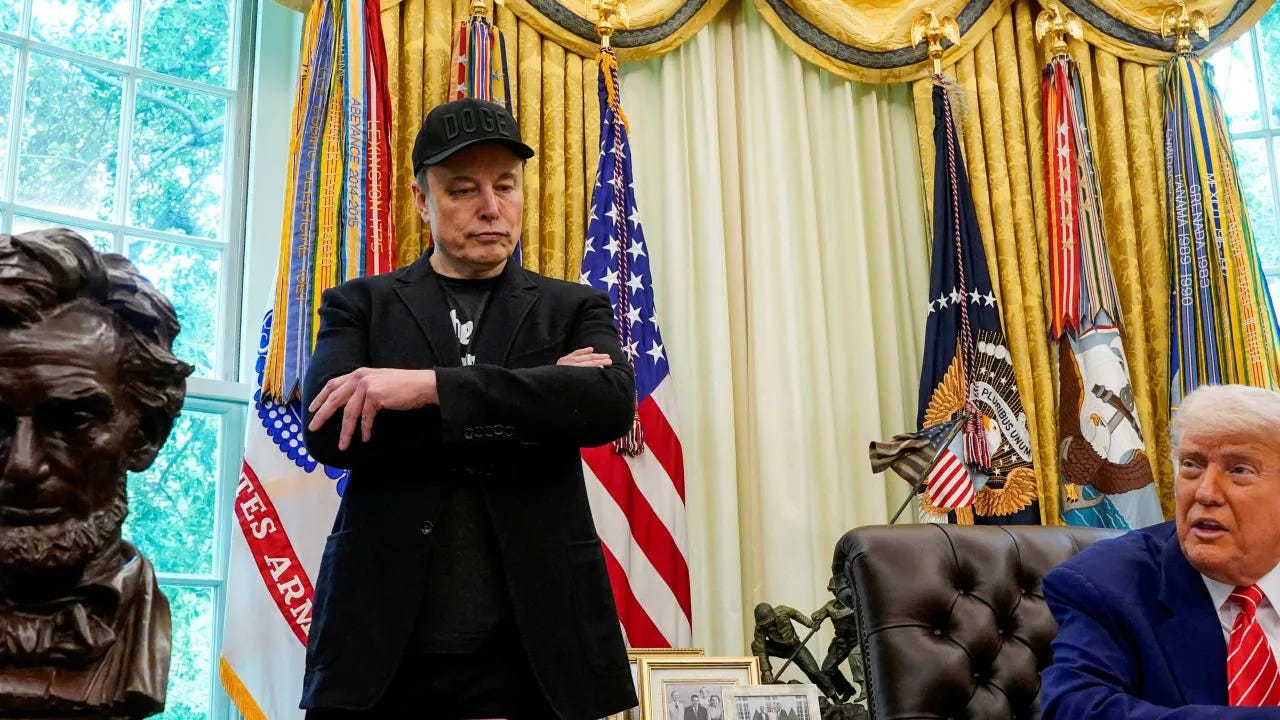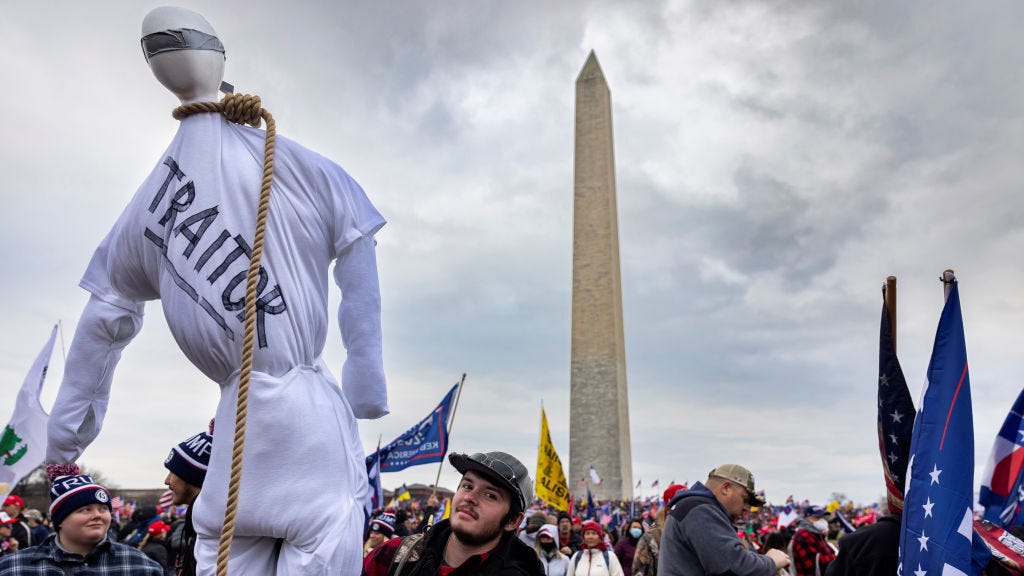Elite disintegration
‘Great empires die not by murder but by suicide’ (Arnold Toynbee)
Well, the honeymoon is over. It was a blast, vrooming around northern Italy with my wife in a mini convertible. There wasn’t much relaxing by the beach, but I did manage to read one book - Peter Turchin’s End Times: Elites, Counter-Elites and the Path of Political Disintegration. Yes, I finally managed to read the book that every other scribbler wrote about when it was published two years ago. It was poignant to read Turchin’s book in the last couple of weeks, amid the bust-up between Donald Trump and his one-time favourite Elon Musk, while the National Guard faces off against protestors in Los Angeles. Because this is the book’s central theme: intra-elite competition and popular immiseration combining to lead to social breakdown and violence.
Peter Turchin is a Russian-American scientist who has developed a new field called Cliodynamics, a sort of complexity science which he began by applying to other species and then started to apply to human societies. In 2010, he came out with a theory that societies inevitably go through periods of disintegration and revolution every 50-100 years or so, and he predicted western societies were about to go through a similar period in the 2020s. Turns out he was right, and since then a lot of thinkers, from Bari Weiss to Dominic Cummings, have embraced his theory to help make sense of our tempestuous times.
I will briefly lay it out and then at the end suggest what it has to do with psychedelics.
The basic theory is this:
Cliodynamics is a quasi-scientific attempt to analyse the systemic structural features underlying the rise and fall of societies and civilizations. It reminds one of Hari Seldon’s Psychohistory, in Isaac Asimov’s Foundation, which Seldon uses to predict social events centuries into the future.
The core variable that underlines societies’ collapse into violence, Turchin thinks, is increasing inequality. The rich get richer and richer until an oligarchy or plutocracy emerge, which then acquires power and ‘inevitably starts using this power in self-interested ways’. In Turchin’s analysis, this occurred in the US starting in around the 1970s, with the rise of neoliberalism and the widening inequality gap between the richest and poorest in the US, and its ballooned in the last two decades with the growth of the extremely wealthy centimillionaire and billionaire class (many of whom, by the by, also take psychedelics and fund the psychedelic renaissance - more on this later).
This widening inequality has two outcomes. First, elite overproduction.
Every society has an elite. In a healthy society, the elite is more or less integrated into wider society, sees itself as part of that society, shares values with the lower classes of that society, and so on. But in times of widening inequality, the elite detaches itself from the lower classes, developing its own self-interested values and culture and lifestyles and religion (or lack of religion). They become more and more selfish and blind to the interests or cares of those poorer than them. They may retreat to gated island communities, or they may try to seize state power to advance their agendas and make themselves ever richer.
Turning on the ‘wealth pump’, as Turchin puts it, then leads to elite over-production, which is his biggest predictor of impending social collapse. More and more millionaires and billionaires appear - there were just 66 US billionaires in 1990, now there are around 750. There are also more and more ‘elite aspirants’ - people jostling for membership or leadership of the elite. This is partly through the expansion of higher education and the increase in graduates, who in the US spend hundreds of thousands in the hope or expectation of joining the elite.
More millionaires and more graduates sound like positive developments, except Turchin argues there are only a fixed number of positions of power in the elite - only so many professors, so many law partners, only so many senators and one president. You have more and more members of the elite competing for power and status, as in a game of musical chairs, but there are only so many seats. This leads to intense elite competition - starting in children competing for Ivy League places - and the competition leads to envy, resentment, status anxiety, and a lot of disappointed expectations when things don’t work out.
That’s when you start to see ‘counter elites’ - members of the elite who reject the standard rules of the game and usual values of the elite in order to try and attain status through a new game.
In some ways, when a trust-fund kid rejects his Hampton parents and goes off to be a shaman in the Amazon, he is becoming a member of the counter-elite. Likewise Greta Thunberg setting off for Gaza in her freedom boat, she’s a member of the counter-elite. Luigi Mangione deciding to gun down the CEO of a health insurance company in the streets, he’s definitely a member of the counter-elite. Sometimes counter-elites will also try and seize political power and change the rules of their society.
Some, like the economist Noah Smith, have blamed the political destabilization of the 2020s partly on the boom in graduates and especially humanities graduates in the 2000s, which Smith suggested created hordes of humanities grads who left college expecting a decent living and didn’t find it, and they were pissed and wanted to tear the system down. They may not be able to make a decent living as writers, but by God they can destroy someone’s career in an afternoon on Twitter.
Turchin writes:
the credentialed precariat (or, in the jargon of cliodynamics, the frustrated elite aspirant class) is the most dangerous class for societal stability. Overproduction of youth with advanced degrees has been the most significant factor in driving societal upheavals, from the Revolutions of 1848 to the Arab Spring of 2011.
This process of elite over-production, intra-elite competition and the rise of counter-elites eventually leads to elite disintegration and all-out-war between the elite and various counter-elites who want to burn the system down so they can attain the power and status they think they deserve.
Mass immiseration
The second key outcome of widening inequality is mass immiseration - the poor get poorer, their lives get worse in terms of wages, housing, social services, life expectancy and so on, and they become more desperate and open to radical solutions. This creates a tinder box ready to explode if someone lights the fuse. Turchin identifies various ways the situation for non-graduates has been getting steadily worse over the last five decades in the US - stagnating relative wages, rising ‘deaths of despair’, falling life expectancy, jobs lost to outsourcing or new technologies. All of this leads to a sense of rage and feeling of betrayal by the elites. This is what Tucker Carlson tapped into, according to a New York Times analysis of 1150 episodes of his cable news show - he hammers away at ‘them’ - the elite, who want to control ‘you’, the white working class, and replace you with immigrants. ‘They’ are corrupt, decadent, selfish, even demonic, and they deserve punishment. The Qanon / MAGA warning - a storm is coming, tribunals, public hangings, this is not a game…
Mass immiseration creates an opportunity for counter-elite opportunists and ‘political entrepreneurs’ to tap into this popular rage. That’s what Dominic Cummings and Boris Johnson did with Brexit. That’s what Donald Trump did in 2016 - his election, says Turchin, was less about Trump and more about the rage of the masses. ‘Happy societies don’t elect Donald Trump’ as Tucker Carlson put it. RFK’s campaign in 2024 was another example of a counter-elite political opportunist. So was Elon Musk’s brief foray into frontline politics.
These two key variables - elite over-production and mass immiseration - interact to lead to social disintegration and, often, revolution and civil war. Turchin outlines three phases to end times:
1 - Elite disintegration: the rise of counter elites and the radicalization of society
2 - Collapse of the state and its monopoly on violence: civil war, revolution and (in 80% of cases) bloodshed, sometimes on an awful scale
3. Reintegration: elites stop fighting (often because so many have died) and create a new covenant with each other and with the masses, there is redistribution of wealth and lower inequality, and a new sense of national unity. A period of peace and prosperity ensues, leading to greater wealth, greater inequality, elite over-production and popular immiseration, and round we go again!
Various other factors complicate this process - geopolitical (what’s happening in other countries), climatological, ideological, and so on. What’s uncertain is how bloody the disintegration process is and how long it lasts, or what sort of counter elites and political opportunists arise and what solutions to the crisis they offer - fascist, communist, racist, conspiracy-theorist, fundamentalist, Luddite etc.
To get a sense of the range of possible outcomes, at one end you have the various labour crises of Britain in the 19th century (the Chartist revolt and so on), which the British parliamentary system navigated more or less effectively, avoiding revolution and widespread bloodshed by extending the vote to all men. At the other end of possible outcomes, you have the Taiping Rebellion, also in the 19th century, in which a man who repeatedly failed the Chinese civil service exam led a religious revolt against Chinese Confucianism, instigating a civil war in which somewhere between 30 and 70 million people died.
What’s it going to be, America?
Turchin calls Cliodynamics a ‘dismal science’, and it does remind one of political Malthusianism - the ‘wealth pump’ creates too many elite aspirants and the typical resolution is for a lot of them to die off, until society stabilizes around a new covenant between the elite and masses. But Turchin insists the range of possible outcomes after elite disintegration is wide - from violent deaths in the hundreds to violent deaths in the tens of millions. So how could a society and its elite / counter-elite try to steer through the rapids?
According to Turchin, there needs to be a new covenant between the elite and the masses. The Democrats, who in Turchin’s analysis are now the party of the elite status quo, adopted various social justice movements - DEI, Black Lives Matter, LBGTQ+, Net Zero, Free Gaza etc - which unfortunately only further alienated them in the eyes of the working class majority and made them look out of touch and more concerned with minority interests or global affairs than the pains of their own traditional working class. These social justice movements could sometimes paint the white working class as the problem, as ‘deplorables’ in centimillionaire Hilary Clinton’s unhappy phrase.
Meanwhile, the MAGAfied Republican party - in Turchin’s analysis now a revolutionary party - more convincingly tapped into the rage of the working classes and promised it the chance to smash the system and drain the swamp. However, it resisted the one thing that would actually stabilize the situation in Turchin’s analysis - wealth redistribution and lowering of inequality.
A new covenant could presumably combine some of these things - wealth redistribution with the nationalism, strong borders and protectionism of the MAGA right, all with some sort of collective moral re-awakening and reaffirming of traditional American liberal-Christian core values - honesty, hard work, the family, civic virtue etc. But that’s my guess, I am not a political entrepreneur and it’s unpredictable what will emerge - I imagine countless political start-ups will rise and fall in the coming years.
Psychedelics and elite disintegration
There’s still the question…what to do with all the elite aspirants? You still have too many players in the game of musical chairs. You still need fewer angry impoverished scribblers on Twitter, and more plumbers. Well, you could send them to Mars, or to the Amazon jungle to become shamans. You could tell them, ‘I’m afraid there isn’t enough space for you all to rise to the top economically and politically, however we are going to finance a percentage of you to go and explore the extended DMT cosmos…Go forth, brave voyager!’
Naturally, while reading Turchin’s grand theory, I wondered what role the psychedelic renaissance plays in the complexity playing out in the halls of the White House and the streets of LA. I think it’s probably just cranking up the variable of ‘Weirdness’, leading to the naked lady protesting on the streets of LA with a sign saying ‘Everyone Take Ayahuasca’.
On the one hand, I think it’s possible that elite shamanification and Burning Man culture enhanced elite separation from ordinary people’s values. Various members of the elite embraced this quirky and slightly cultish idea that ‘psychedelics will save the world’...which I guess is more attractive than ‘wealth redistribution’, but I don’t think is ultimately going to be the basis of a new national covenant.
I also think it’s possible that psychedelics amplified the egos of various members of the elite and gave them the sense they are cosmic superheroes who deserve to lead society. I think of Aubrey Marcus taking ketamine and having a vision that RFK would win the presidency, or crypto billionaire and psychedelic investor Brock Pierce taking who knows what and deciding it was his cosmic destiny to run for US president or to save Puerto Rico.
Certainly, some members of the psychedelic elite thought that the MAGA revolution gave them a radical window to push through their agenda and get psychedelics legalized in the US, even if they didn’t pass the usual FDA approval process. And who knows, they may succeed. But we’re in a chaotic situation which is changing daily.
For a while, Elon Musk seemed like the second-most-powerful man in the United States, the unofficial president, deciding government appointments by Twitter poll, spending all his time by Donald Trump’s side in Mar-y-Lago. Musk’s political ascendancy seemed like very good news for psychedelics, because the court of Musk loves psychedelics, and if the court of Musk is bankrolling and even running the MAGA movement, and the Musks, Antonio Gracias et al wants psychedelics approved, then psychedelics will be legalized, right? It certainly looked possible.
Does that mean Musk’s sudden fall from grace is bad news for the psychedelic movement in the US? Who knows. There are populist factions in the MAGA movement who are hostile to psychedelics - look at the opposition to Casey Means’ appointment as Surgeon-General because she promoted shrooms - and who are also hostile to the Burning Man Tech Right. A lot of the criticism of Musk now, from the right and from the left, centres on his messy drug use and how this may have affected his judgement, not to mention his bladder (according to the NYT). The most high-profile supporter of psychedelics in the US has become the most high-profile casualty of the psychedelic renaissance.
All of that is kind of a tiny side-bar amid the wider revolutionary geopolitical dynamics at play, but hey, that’s our beat!
More Tuesday links after the paywall - former head of the Pentagon’s UAP unit says a prank may have inspired many servicemen to believe in flying saucers; two gruesome psychedelic-related deaths; an excellent profile of Graham Hancock, who Peter Thiel apparently wanted to hire to investigate UAPs; and a follow-up to my story on Roger Bardales and his shamanic sex cult. Oh, and come to this free online discussion in an hour on US psychedelic policy - go fast or slow down? Featuring myself and MAPS director of safe access Philippe Lucas.
Keep reading with a 7-day free trial
Subscribe to Ecstatic Integration to keep reading this post and get 7 days of free access to the full post archives.





